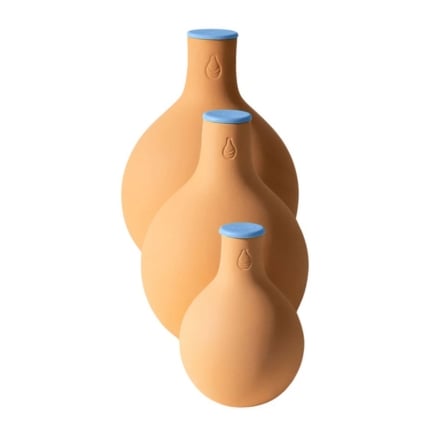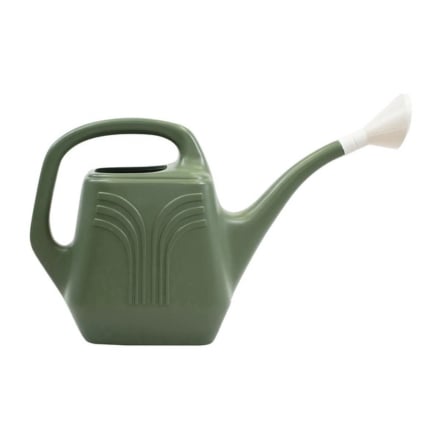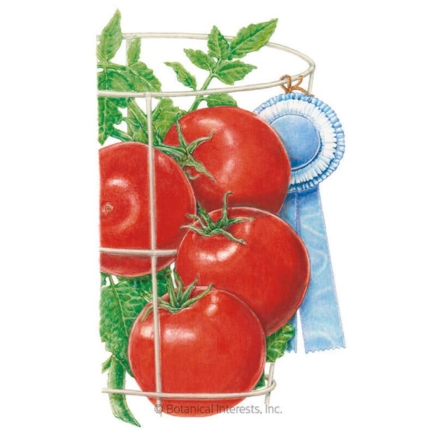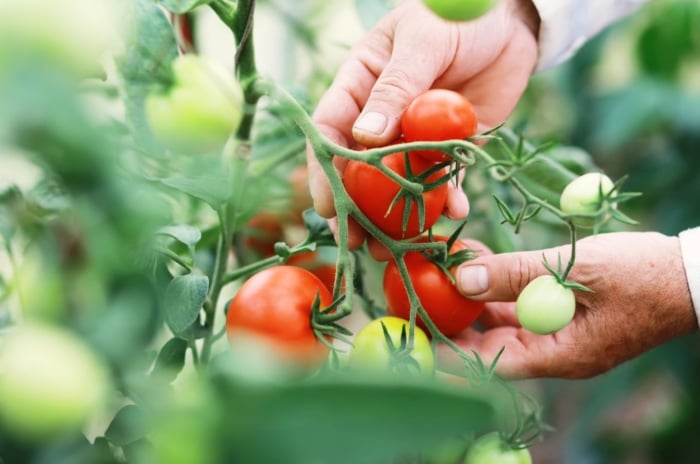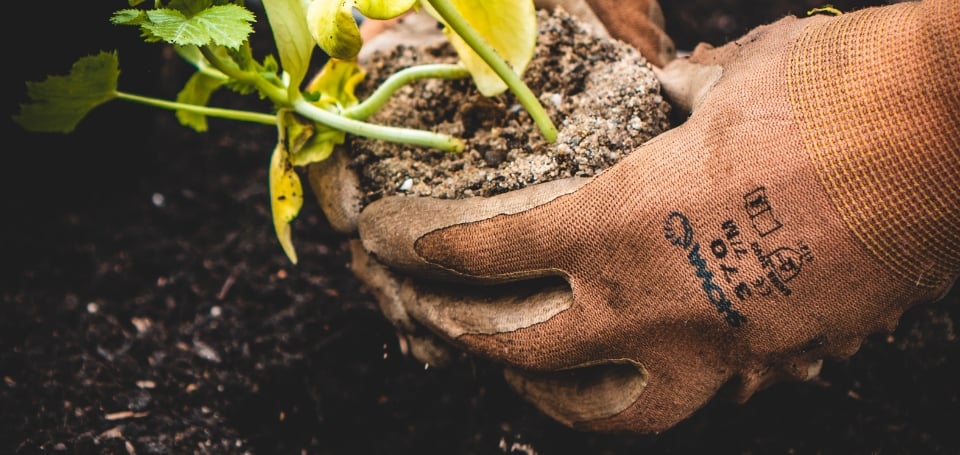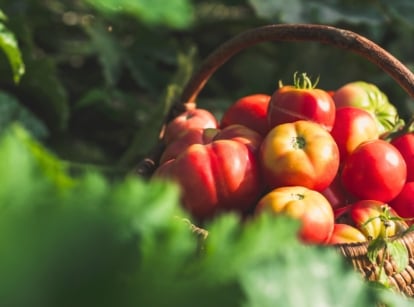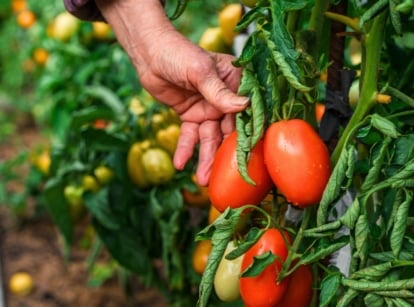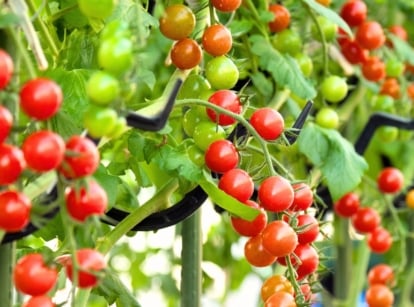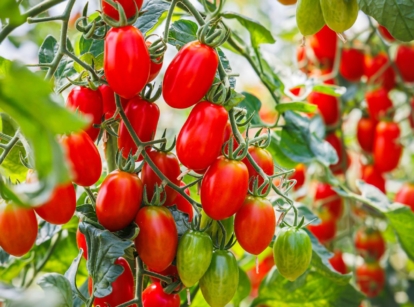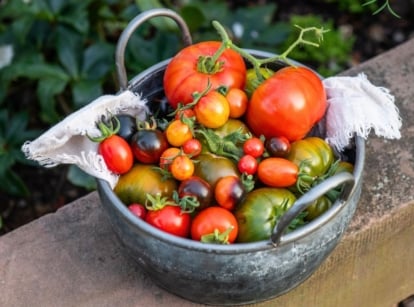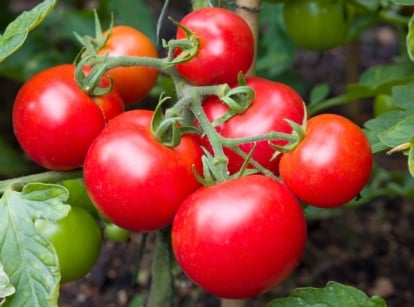5 Watering Mistakes That Kill Tomato Plants
Keeping your tomatoes properly hydrated is an essential part of plant care. But watering too much, not enough, or at the wrong intervals, can kill tomato plants. Join farmer Briana Yablonski to learn a few tomato watering mistakes to avoid.

Contents
Knowing how much and how often to water tomato plants can be a tricky subject to master. You probably know you don’t want the soil to dry out completely or remain soaking wet, but how exactly should you water tomato plants?
How much water is too much? Should you grab the sprinkler or the hose? Did your plants die because you didn’t provide enough water?
Learning a few of the common watering mistakes that can kill tomato plants is a good place to start. I’ll cover some irrigation errors gardeners make and how they can negatively impact plants. Avoiding these mistakes will help keep your plants healthy and productive throughout the growing season.
Watering Too Often

Some gardeners are so worried about keeping their tomatoes well-watered that they end up irrigating too much. Most tomatoes require about one to three inches of water per week. If you’re watering more than this, there’s a good chance your plants may be experiencing issues stemming from too much water.
Overwatering tomatoes can occur when you water your plants too often or apply too much water each time you irrigate. Both of these practices can lead to saturated soils and numerous plant issues. Here are a few ways adding too much water can kill tomato plants.
Root Rot

Root rot is a general term used to describe rotten plant roots. Numerous fungi, including members of the Phytophthora, Pythium, and Fusarium genera, can cause roots to become soft, discolored, and squishy. These fungi are more likely to infect roots when the soil remains constantly moist, which explains why they often occur alongside overwatering.
As root rot progresses, it negatively impacts the roots’ ability to take up water and nutrients. That means you shouldn’t assume wilting leaves and stems indicate that the plant needs more moisture. Instead, check the soil before watering.
If the top two to three inches of water are dry, go ahead and water. Hold off on watering if they still feel moist.
Nutrient Deficiencies

Frequent irrigation can wash soluble nutrients out of the soil. Not only does this mean you’re wasting money on fertilizer and harming the environment, but your plants may also show signs of nutrient deficiencies.
Not all nutrients are susceptible to leaching, but nitrogen, sulfur, and potassium can easily wash out of the soil. Providing a slow stream of water and avoiding saturated soils will limit nutrient loss from leaching.
Not Watering Enough
Failing to water your plants enough can cause numerous types of stress. Underwatering can occur if you water shallowly or only apply a small amount of water each week. Here are a few of the issues that underwatering tomatoes can cause.
Problems With Nutrient Uptake

Most nutrients are reliant on water to move from the soil and into plants. Even if there are adequate amounts of calcium, nitrogen, and phosphorus in the soil, plants will have a difficult time taking up nutrients if the soil is dry.
First, water is essential for the decomposition of organic matter. Organic fertilizers consist of complex molecules, and the nutrients aren’t immediately available to plants. Moisture allows microbes to break down these larger compounds into smaller ones that plants can use.
Moisture is also an essential part of nutrients traveling from the soil and into the plants. When gardeners spot blossom end rot, they often think a lack of calcium is to blame. And while a calcium deficiency in the plants causes these black tomato bottoms, blossom end rot doesn’t necessarily indicate a deficient soil. Underwatering can cause problems with calcium traveling from the soil to the plants, leading to the rotten bottoms.
A lack of water also inhibits the uptake of nutrients besides calcium. Therefore, make sure you’re providing an adequate amount of water before you assume nutrient deficiencies in the plant indicate nutrient-deficient soil.
Issues With Fruit Development

Underwatering can cause plants to develop issues with flower production and fruit development. If you don’t have any flowers, you won’t have any tomatoes! And if your tomatoes don’t develop and ripen, you won’t be able to enjoy the moment of biting into a juicy, ripe fruit.
Paying attention to the soil moisture and watering when necessary will allow the tomato plant to receive the water it needs to develop healthy fruits.
Using Overhead Irrigation

How you water your tomato plants is just as important as how often you water them. These plants are vulnerable to all types of foliar diseases, and wet leaves are more susceptible to infection. Using sprinklers, hoses, and other types of overhead irrigation wet the leaves and increase the likelihood that plants will die.
Overhead irrigation can also splash the soil onto the plants, increasing the risk of soil-borne diseases.
Increased Risk of Fungal Diseases

The main risk of using overhead irrigation is the increased risk of fungal diseases. Some common fungal diseases that impact tomato plants include early blight, Septoria leaf spot, late blight, and gray mold.
Some of these diseases live in the soil and infect plants when the soil splashes onto the plant’s leaves. Other diseases infect plants when their spores float in from other locations.
Avoiding heavy overhead irrigation helps prevent soil splash and the resulting infection. It also helps keep the leaves and limits the chances that the disease will take hold.
Alternative Irrigation Options

Fortunately, there are numerous ways you can water your tomato plants and keep their leaves dry.
Setting up a drip irrigation system is an excellent option if you have a larger garden or just want to simplify and/or automate your irrigation process. It requires an upfront investment in supplies and time, but once the system is set up, all you have to do is turn on the spigot and walk away. The drip tape will supply a slow and steady stream of water to the plants’ roots, allowing it to infiltrate into the ground.
If you don’t want to set up an entire system, you can stick with a hose or watering can. Just make sure to slowly apply water near the base of the plant.
Inconsistent Irrigation

Allowing the soil to alternate between bone dry and soaking wet will lead to intense swings in moisture within the plant. You know how we like to stay adequately hydrated rather than alternating between thirsty and overly full from water? Tomato plants have similar preferences.
It’s okay, and preferred, to allow the soil to dry slightly in between irrigation events. That said, you should irrigate before the deep layers of soil dry out.
Cracked Fruits

When the soil quickly changes from dry to wet, tomato plants experience a sudden uptick in moisture. Fruit cells rapidly expand, and the skin can’t always keep up with this rapid growth. The result is cracks near the tomato’s calyx or even on the bottom of the fruit.
These cracks don’t render tomatoes inedible, but they open the fruits up to infection. Cracked tomatoes are more likely to rot on and off the plant, limiting quality and storage life.
Keeping the soil consistently moist as your plant grows allows the fruits to slowly absorb moisture. This allows the skin to grow with the interior of the fruit and lessens the likelihood of cracked tomatoes.
Nutrient Deficiencies

If you apply all of a plant’s required weekly water on a single day, the soil will be extremely wet one day and dry six days later. The heavy irrigation may wash nutrients out of the soil, and the dry soil may prevent proper nutrient uptake.
A better option is to break up this irrigation over a few days. This steady irrigation will help keep the soil moderately moist and prevent issues with nutrient leaching and absorption.
Ignoring the Environment

It’s a basic rule that tomato plants need one to two inches of water per week to remain healthy. But this is a suggestion rather than a hard rule. The plant size, temperature, humidity, soil type, rainfall, and other factors all impact how much water you should provide.
Some growers make the mistake of watering on a set schedule rather than paying attention to the environment. You probably know that you don’t need to irrigate your tomatoes on a rainy day, but have you thought about how clay soil holds moisture for multiple days? Or how hot days lead to higher rates of transpiration (that’s the plant equivalent of sweating) and demand more water?
Here’s how various factors impact how often you should water.
Plant Size

In general, you’ll need to water young plants more frequently than larger plants. These young plants still have small root systems that can only reach moisture in the top foot of soil. As the plant’s roots grow larger, they’ll be able to access water that’s held deeper in the ground.
Temperature

Higher temperature leads to higher rates of transpiration, which means plants lose more water as they attempt to cool themselves. Warm weather also causes water to evaporate from the soil more quickly. Add these two factors together, and it’s easy to see why you’ll need to water more during hot weeks.
Soil Type

Your soil type impacts how much water it can hold. Sandy soils consist of large particles that create sizable spaces that water can quickly flow through, clay soils contain small particles and small spaces, and silty or loamy soils fall somewhere in between.
Organic matter acts as a type of buffer when it comes to soil moisture. It improves drainage in heavy clay soils and allows sandy soils to hold more moisture.
In general, you’ll need to water sandy soil more often than clay soil. It’s okay if you’re not sure of your soil type. Just pay attention to how quickly water flows through it and then use this observation as your guide.

